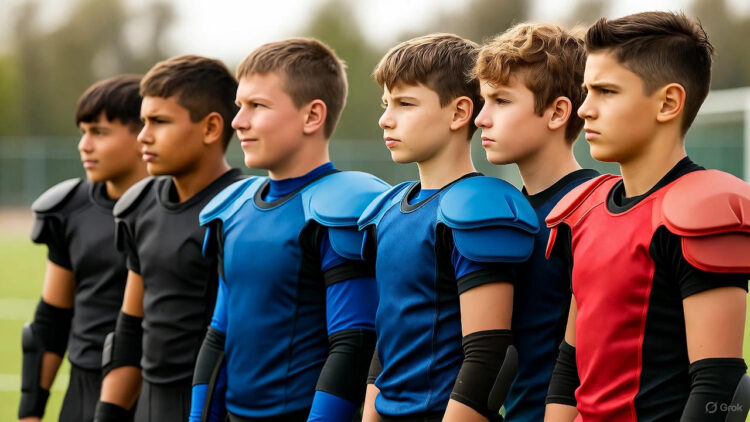Introduction
Youth sports participation continues growing nationwide, with over 45 million children engaging in organized athletics annually. As participation increases, so does parental and coaching awareness about injury prevention and player safety. Among the most significant advancements in protective equipment are youth padded compression shirts, which provide essential protection without compromising mobility or comfort.
These innovative garments combine compression fabric technology with strategically placed padding to protect vulnerable areas during contact sports. From football and lacrosse to hockey and rugby, young athletes face impact risks that proper equipment can significantly reduce.
Understanding the Youth Athlete Safety Landscape
The Centers for Disease Control and Prevention reports that approximately 2.6 million youth athletes receive emergency room treatment for sports-related injuries annually. While not all injuries are preventable, appropriate protective equipment substantially reduces both injury frequency and severity.
Traditional padding systems often prove bulky and restrictive for younger players. Youth padded compression shirts address this limitation by integrating protection directly into form-fitting base layers. This design philosophy provides coverage where children need it most while maintaining the flexibility essential for athletic performance.
Research from the American Academy of Pediatrics emphasizes that proper protective equipment must fit correctly to function effectively. Ill-fitting gear creates both safety risks and discomfort that discourages young athletes from wearing protection consistently. Compression-based designs naturally conform to various body types, ensuring appropriate fit across different ages and sizes.
Key Protection Areas in Youth Padded Compression Shirts
Quality youth padded compression shirts strategically place protective elements in high-impact zones:
Shoulder Protection: Pad coverage over shoulder caps and clavicle areas absorbs impact from collisions and falls. This protection proves particularly valuable in football, where shoulder contact occurs frequently during blocking and tackling.
Rib Cage Shielding: Lateral padding protects vulnerable rib areas from direct hits and accidental contact. Rib injuries can be particularly problematic for young athletes whose bones are still developing.
Spine Guards: Back padding runs along the thoracic spine, protecting against impacts from behind. This feature provides peace of mind for parents concerned about back injuries.
Sternum Coverage: Front chest padding guards the sternum and heart area during frontal impacts. This protection addresses one of parents’ primary safety concerns in contact sports.
According to data from USA Football’s health and safety initiatives, athletes wearing comprehensive padding systems experience 34% fewer contusions and soft tissue injuries compared to those with minimal protection.
Material Science and Comfort Engineering
Modern youth padded compression shirts utilize advanced materials that balance protection with wearability:
Moisture-Wicking Fabrics: High-performance synthetic blends pull sweat away from skin, maintaining comfort during intense activity. Young athletes who stay dry and comfortable are more likely to wear protective gear consistently.
Breathable Construction: Mesh panels and ventilated padding prevent overheating. Heat management proves especially critical for youth athletes, whose thermoregulation systems are still developing.
Four-Way Stretch: Elastic fabric allows full range of motion without restriction. Young players need to run, jump, and move naturally regardless of protective equipment.
Antimicrobial Treatments: Many youth padded shirts incorporate treatments that resist odor-causing bacteria. This feature matters for equipment that contacts skin directly and requires frequent use.
Lightweight Padding: Modern foam technologies provide impact protection without adding significant weight. Padding weight distribution ensures young athletes don’t fatigue prematurely from equipment burden.
Sport-Specific Applications and Benefits
Different sports present unique impact patterns requiring specific protection approaches:
Football: Youth padded compression shirts serve as excellent foundation layers under shoulder pads. They provide additional protection in areas standard pads miss while reducing friction and improving comfort.
Lacrosse: These shirts offer crucial rib and spine protection during the physical contact inherent to lacrosse. The compression fit prevents shifting during rapid directional changes.
Hockey: Under hockey equipment, padded compression shirts add protection layers while managing moisture from intense activity in cold environments.
Rugby: The minimal equipment rules in youth rugby make compression padding particularly valuable. These shirts provide legal protection within sport-specific regulations.
Baseball/Softball: Catchers and infielders benefit from padding that protects against foul tips and hard-hit balls while maintaining the mobility these positions demand.
Sizing and Fit Considerations for Growing Athletes
Proper fit determines protective equipment effectiveness. Youth padded shirts should fit snugly without restricting breathing or movement. Parents and coaches should consider:
Growth Allowance: Children grow rapidly. Select sizes accommodating expected growth over a season while maintaining current fit effectiveness. Most manufacturers provide detailed sizing charts based on height, weight, and chest measurements.
Padding Alignment: Protective elements must cover intended areas. Shirts that are too large allow padding to shift out of position, negating protective benefits.
Comfort Testing: Have young athletes perform sport-specific movements while wearing gear. Jumping, running, and reaching should feel natural, not constrained.
Seasonal Adjustments: Athletes may need different sizes for fall versus spring seasons as they grow. Regular fit assessments ensure continued protection and comfort.
Building a Culture of Safety in Youth Sports
Equipment represents just one component of comprehensive safety programs. Coaches and parents should also emphasize:
Proper Technique: Teaching correct form reduces injury risk more effectively than any equipment. Safe tackling, falling, and contact techniques are fundamental.
Conditioning Programs: Strong, flexible athletes resist injuries better than deconditioned ones. Age-appropriate strength and conditioning supports injury prevention.
Concussion Protocols: Youth padded compression shirts protect against body impacts but don’t prevent concussions. Proper concussion education and protocols remain essential.
Equipment Maintenance: Regular inspection ensures padding maintains protective properties. Damaged or compressed foam loses effectiveness and requires replacement.
Progressive Contact: Gradually increasing contact intensity as skills develop reduces injury risk while building confidence and proper technique.
Economic and Practical Considerations
Parents often balance safety desires against budget realities. Youth padded compression shirts offer excellent value propositions:
Multi-Sport Utility: A single quality shirt often works across multiple sports, maximizing investment value.
Durability: Well-constructed compression padding withstands entire seasons or longer with proper care.
Reduced Medical Costs: Injury prevention equipment pays for itself many times over if it prevents even one emergency room visit or missed season.
Insurance Compatibility: Some youth sports insurance programs offer premium reductions for teams using certified protective equipment.
Coach Jennifer Martinez, with 15 years of youth football experience, observes: “Since our program mandated youth padded shirts five years ago, we’ve seen dramatic decreases in minor injuries that previously sidelined players. Parents appreciate the visible commitment to safety, and players love how the gear feels.”
Conclusion
Youth padded compression shirts represent a crucial evolution in protective sports equipment. By combining advanced materials, strategic padding placement, and comfortable design, these garments provide young athletes essential protection without sacrificing performance or mobility.
As youth sports continue growing in intensity and competitiveness, appropriate safety equipment becomes increasingly important. Parents and coaches who prioritize protection send clear messages about athlete welfare while reducing injury risks that can impact children’s long-term health and sports participation.
Investing in quality youth padded shirts demonstrates commitment to player safety while enabling young athletes to compete confidently. When children feel protected and comfortable, they focus on skill development, teamwork, and enjoying sports rather than worrying about injury risks.















